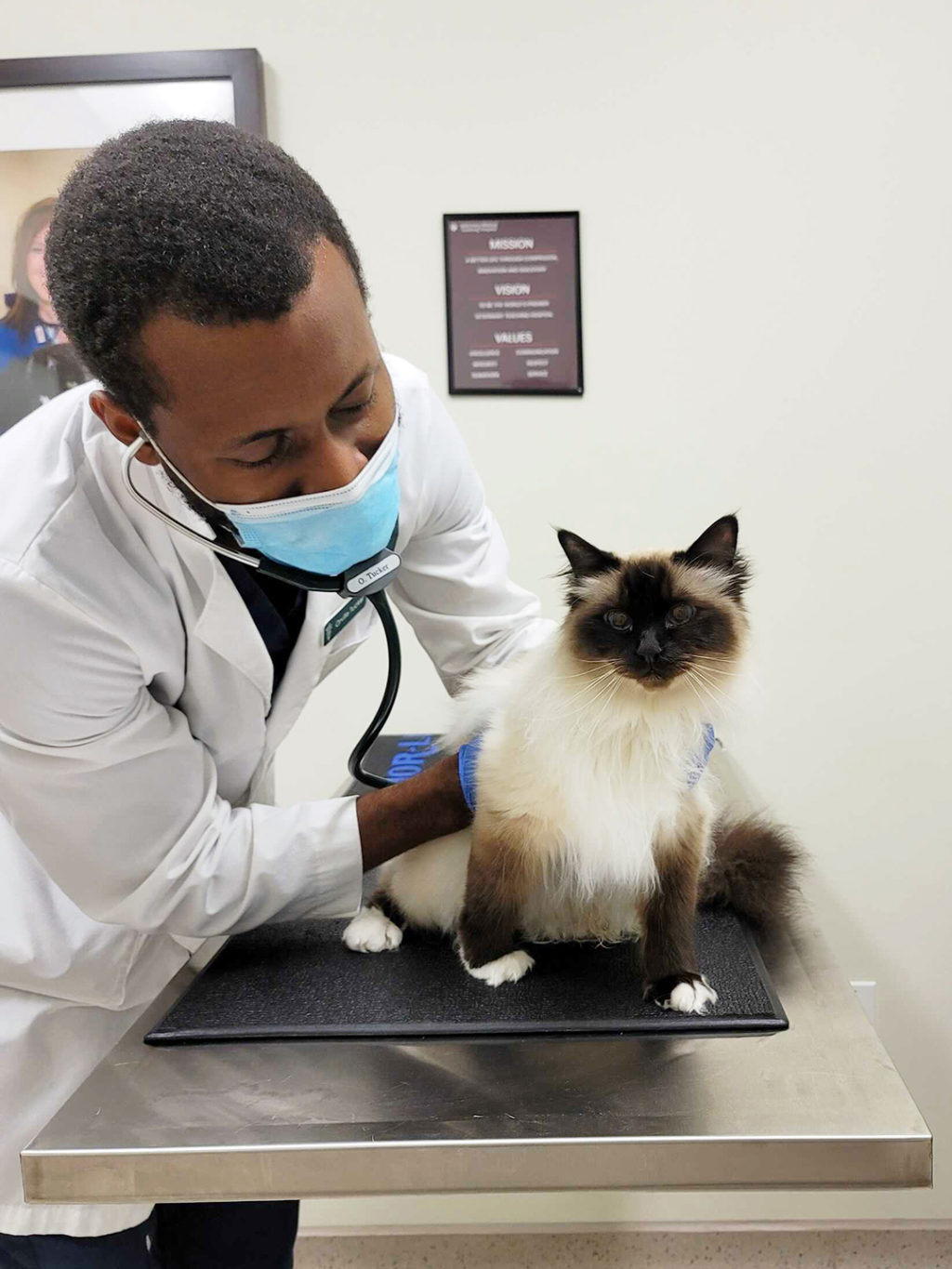Texas A&M Veterinarians Make Serendipitous Diagnosis Of Cat’s Rare Autoimmune Condition
Story by Megan Myers, VMBS Communications

Baxter, a 12-year-old seal point Birman cat, tends to draw eyes wherever he goes.
“He is such a pretty cat,” said Baxter’s owner Erin Young. “He just prances around, looking beautiful and knowing that he’s so beautiful. He’s a joy for our family and he’s a very special cat, to say the least.”
Young and her husband, William, fell in love with the Birman breed when their first cat together, another seal point named Socks—who passed away in 2008—joined their family.
“We wanted to get another male seal point Birman because we loved Socks so much,” Young said. “We were moving to London later that year and decided to wait until we got there to look for a Birman. They were kind of hard to find but we finally found a breeder with a litter of five kittens—four of whom were female chocolate points—and one was the male seal point I’d been searching for for such a long time.”
Baxter quickly established his place as “the boss of the house,” which included the Youngs’ three children and two small terrier dogs.
The Youngs’ extreme love for Baxter and his important role in their family made it all the more frightening when he suddenly became severely ill in December 2020.
“We were at our vacation house at Lake Athens, when, one day, he started acting weird and foaming at the mouth,” Young said. “He looked terrible, so I rushed into the vet in Athens. They thought he had a urinary blockage, but he just kept getting worse and worse.”
Wanting to get Baxter a diagnosis as soon as possible, Young brought him to the Texas A&M Small Animal Teaching Hospital (SATH), where he had previously been treated for liver disease.
Upon arrival, Baxter was checked in to the Intensive Care Unit (ICU) and his veterinary team began running tests. His doctors found three major issues: asthma, inflammatory bowel disease (IBD), and pancreatitis.
Thankfully, the pancreatitis was resolved during Baxter’s stay at the SATH and his chronic issues of asthma and IBD could be managed at home with a specialized diet and some environmental changes.
But during one of Baxter’s rechecks with his veterinarian in Dallas, the pathologist running his blood test noticed something abnormal, which led to a surprising diagnosis when his blood test was rechecked at Texas A&M.

“The clinical pathologist looking at a blood smear from Baxter’s bloodwork found that his red blood cells were agglutinating (clumping together) at room temperature, but they did not agglutinate when at his normal, warmer body temperature,” said Dr. Leigh Ann Howard, a third-year internal medicine resident at the SATH and the primary veterinarian on Baxter’s case. “This is consistent with cold agglutinin disease (CAD), a rare autoimmune blood disorder.”
With CAD, antibodies that attack red blood cells have enhanced activity at temperatures of less than 99° F. Although the disease was first reported in cats in 1983, it has been very rarely diagnosed.
Generally, agglutination can cause serious anemia, leaving a patient without enough red blood cells to carry oxygen throughout the body. Because Baxter’s cells only clump together at temperatures cooler than his body temperature, which is normally between 100.5 and 102.5° F, he is unlikely to experience any consequences of CAD.
However, there is still a chance of danger if Baxter were exposed to cold temperatures for an extended period of time.
“Cold temperatures can cause agglutination in the small blood vessels in his extremities, including his ear tips, tail tip, and nose,” Howard said. “This can cause the skin of those areas to become necrotic and shed off.
“We hope that as long as Baxter remains indoors in a comfortable temperature and does not experience hypothermia, he should not have problems with his blood agglutinating,” she said.
Considering how devoted Baxter’s family is to him, his veterinarians are confident they will keep him warm and cozy for the rest of his life.
“Baxter is a very sweet and handsome guy. He is also the first CAD patient that I, or any of our medicine team, from what I gather, have ever seen,” Howard said. “It is a rare diagnosis, but because it does not cause clinical disease in most cases, it might fly under the radar, and healthy cats may have CAD that is never diagnosed.”
While the cause of Baxter’s CAD may never be known, Howard believes it could be related to genetics or an underlying condition.
“For now, we will monitor Baxter for signs of illness and perform periodic bloodwork to monitor for the development of anemia and/or severely elevated globulins, which are proteins that form the antibodies that are causing the agglutination in cold temperatures,” Howard said.
Baxter will be getting rechecks and bloodwork to monitor his CAD and other chronic conditions every three months, alternating between Texas A&M and his primary veterinarian, Dr. Stephanie Chritton ’87, at Hillside Veterinary Clinic.
“Dr. Chritton really goes above and beyond,” Young said. “She has been such a great advocate for Baxter and a great liaison between Hillside and Texas A&M. She’s a phenomenal vet.”
In the meantime, Baxter is now back to normal and living without any consequences of his CAD.
“We are very grateful that his veterinarians at Texas A&M figured it out,” Young said. “Texas A&M also saved one of our little dogs who had a very rare disease. He was so sick, even dying, but no one could figure it out. Then I took him to Texas A&M and they diagnosed him in a day.
“After that, I decided that if I ever have a very ill animal, the pet’s going straight to Texas A&M. I don’t know if Baxter’s outcome would’ve been the same if we had gone somewhere else.”
###
Note: This story originally appeared in the Summer 2022 edition of CVMBS Today.
For more information about the Texas A&M School of Veterinary Medicine & Biomedical Sciences, please visit our website at vetmed.tamu.edu or join us on Facebook, Instagram, and Twitter.
Contact Information: Jennifer Gauntt, Director of VMBS Communications, Texas A&M School of Veterinary Medicine & Biomedical Sciences; jgauntt@cvm.tamu.edu; 979-862-4216


